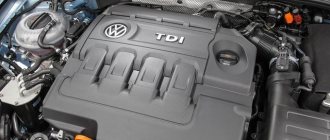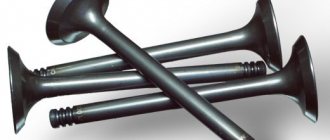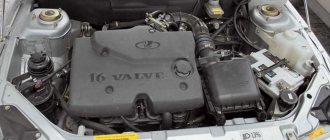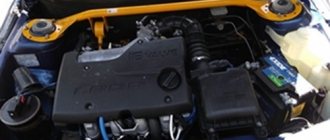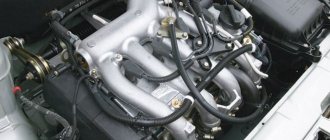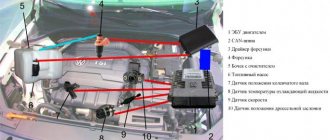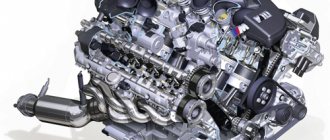The VAZ 21124 engine with 16 valves appeared in 2004, by reconstructing and improving the 2112 engine and was mounted on cars produced by the AVTOVAZ concern, models 2111, 2112, 2111.
The updated internal combustion engine received an increased displacement - 1.6 liters. The increased engine volume of the VAZ 21124 was achieved by increasing the distance between the axes of the main and connecting rod journals of the crankshaft by 7.3 mm (it was 30.5 mm, now it is 37.8 mm). Moreover, the increase in volume occurred without changing the diameter of the cylinders; it remained the same - 82 mm.
Thus, the designers' intention was achieved - bringing the environmental characteristics to the European level. Let's consider its description in more detail.
Design features
The main part of the engine, the cylinder block (catalog number 11193-1002011), also differs in size from its predecessor. It is factory painted blue. Its height, the distance from the crankshaft axis to the upper plane, became 197.1 mm, versus 194.8 mm on the 2112 model.
The dimensions of the holes for the block head mounting bolts have changed; they are from the hoist with M10×1.25 threads. The main bearing supports on the 124th engine, from the second to the fifth, are equipped with channels designed to supply oil that cools the piston during operation.
The crankshaft installed is the same as on models 21126 and 11194, with the marking 11183 cast on the sixth counterweight. Due to the crank radius of 37.8 mm, a piston stroke of 75.6 mm was provided. A toothed pulley is installed on the shaft for timing belt drive. The belt is 25.4 mm wide and has 136 teeth, parabolic in shape. Belt service life is 45,000 km.
The pulley is designed to drive additional units using a V-belt. Three types of belts are used, differing in length, depending on the equipment:
- If the drive is only for the generator, the belt length is 742 mm.
- With power steering - 1115 mm.
- With power steering and air conditioning 1125 mm.
The pulley is designed in such a way that it acts as a damper, reducing the torque loads acting on the shaft. Another function is to determine the position of the crankshaft using a sensor and a gear mounted in the damper.
The improvement affected the pistons. Their bottoms are made with valve recesses 5.53 mm deep to avoid the valves hitting the piston bottom when the timing belt breaks.
On previous VAZ 16v models without recesses or with recesses of shallower depth, in such a situation there was a risk of bending the valves, which led to expensive repairs. So, concerns and frequently arising questions about whether the valves bend on this engine have been removed.
Oil scraper and compression rings are made of steel or cast iron. The pistons and connecting rods are connected using floating pins, 22 mm in diameter, 60.5 mm in length, secured with retaining rings. The pins and connecting rods are borrowed from the VAZ 2110 modification.
The block head for the 16 valve LADA 21124 engine has an enlarged docking area for the intake manifold flange. Both camshafts for the exhaust and intake valves, as well as the valves themselves, springs, and hydraulic compensators have also been preserved from the previous modification of the engine.
In order to avoid confusion, the shafts are marked with a digital code. If it ends at 14, then this is the exhaust valve shaft, if at 15, then this is the intake shaft.
Another difference is that there is a raw strip on the intake shaft, next to the first pushrod. By adding hydraulic compensators to the design, the manufacturer eliminated the need to maintain valves in terms of adjustment. But, they are very sensitive to the cleanliness and quality of the lubricant. Low-quality oil will quickly damage parts and must be replaced; such repairs are not provided for the VAZ 124.
The spring-valve group is similar to model 2112. Valves with one spring and rods with a diameter of 7 mm (on eight-valve heads their diameter is 8 mm). Toothed pulleys with marks for setting the valve timing are installed on the camshafts. Compared to model 2112, the marks are shifted relative to each other by 2°.
Tuning of the internal combustion engine cylinder block, conversion of the 8 valve VAZ-2110 (2112) engine to 16 valve.
Tell me, after reading all the above-mentioned information, are you not inspired by the idea of having a car with 16 internal combustion engine valves? In this case, you will be pleased to know that this kind of modernization is allowed. Of course, this process is thorough and cannot be completed without careful preparation. But the result will really justify itself. If you have any doubts, just read the next few paragraphs of the text.
Without going into technical details, the essence of tuning is to replace the cylinder head with a new one. Of course, now you will have two camshafts, and you will also have to rack your brains over the fastening system, because the diameters of the holes in the 16 valve head do not correspond to those on the 8 valve head.
The mounting holes of the block head should be drilled, increasing the diameter from 10 to 12 millimeters.
You can do this yourself, but it is better to contact a specialized workshop. For this kind of work they should not charge more than 3-4 hundred rubles. It should also be taken into account that the standard mounting bolt for the 16-valve cylinder block is slightly smaller than that for the “eight” and must be shortened accordingly.
It is better to study in advance what a 16-valve engine is like on a VAZ 2110 and then you will certainly be able to carry out this kind of tuning yourself. It will be necessary to change the timing belt, pump pump, rollers, wiring, spark plugs, connecting rod mechanism and other structural elements due to the peculiarity of the cylinder head. The head is assembled separately before installation on the engine. After completing the work, it is also advisable to use specialized services for setting up and calibrating the operation of the internal combustion engine.
Tuning
Simple firmware or chip tuning for 124 engines not the technical characteristics . To significantly increase power, it is necessary to modify the engine.
- The simplest and most common tuning of the 21124 engine is the installation of sports camshafts, a direct-flow resonator, an increased throttle - in this way you can increase the power to 120 hp. Installing a lighter piston engine can add some power to this. This, at the same time, will reduce the fuel consumption of the VAZ 21124.
- About 150 hp can be ensured by modification of the cylinder head and installation of camshafts with increased valve opening phases.
- Installing a compressor has approximately the same effect; it is installed on eight-valve and sixteen-valve engines.
- Stable engine operation at any speed is ensured by installing four chokes, one for each cylinder. According to popular experience, the most suitable option is to install an injection system from ToyotaLevin. To do this, a set is assembled from the chokes themselves, an adapter manifold, a zero-resistance filter, injectors, an absolute pressure sensor and a fuel pressure regulator. Due to the fact that the speed exceeds the limit, it is necessary to install lightweight piston and wide-phase camshafts. With this modification, engine power can reach 200 hp. But such modernization sharply reduces the service life of the engine, is fraught with frequent breakdowns and the need to carry out serious repairs of the VAZ 124, due to the fact that the engine easily and often spins up to 9,000 rpm.
Changing engine displacement
The most favorite tuner engine is 124
This method is one of the simplest and most convenient. Such tuning will significantly increase engine torque without changing your driving style. It can be increased by boring the cylinders or increasing the piston stroke.
- By increasing the cylinder capacity, you will immediately increase engine power . This is based on the fact that there is a reserve in the thickness of the cylinder walls and they can be bored using a special machine. Bored cylinders will burn the greatest amount of fuel in the same amount of time, thereby increasing the throttle response of the engine.
- increase the piston stroke by using a new crankshaft, which has a large eccentricity, and selecting appropriate pistons and connecting rods for it. As a rule, lightweight connecting rods in this case are installed, since weight in this case plays an important role. The new piston group allows to significantly increase efficiency and, accordingly, power. At the end of such tuning, it is advisable to install a lightweight flywheel in order to relieve the load on the crankshaft and clutch, which will certainly have a positive effect on the dynamics and acceleration of the car.
Boring cylinders on a machine.
Compression ratio
- The very concept of compression ratio implies the ratio of the combustion chamber to the total volume of the cylinders. This will simultaneously significantly increase efficiency, engine power and reduce fuel consumption.
- These indicators can be achieved by installing a new camshaft with completely different geometric parameters. Thus, the new element is able to increase the volume of the combustion chamber, while the engine volume remains unchanged. Such work is best carried out together with the installation of a turbine (see below - note). However, remember that this work is not cheap.
- You also need to know that when installing such a camshaft, the octane number of the gasoline being poured must be increased, as well as improving the engine oil being poured, which has the lowest friction coefficients. When carrying out such tuning, compression units can increase to 10 units.
Malfunctions and repairs
The most common malfunction that VAZ 2110 owners encounter is when the 21124 engine fails. This is expressed in unstable engine operation, interruptions in operation, increased vibration, noise and gasoline consumption. What could be the reasons for this unpleasant phenomenon and what repairs will be required on the VAZ 21124 engine.
If the engine in any VAZ 2110 car is malfunctioning, then, firstly, you need to find out the reason, diagnose the ignition, fuel supply system, gas distribution mechanism, electronics and mechanical parts (pistons and crankshaft) and repair the VAZ 124, even if you do it yourself .
- Ignition - the wires are removed from the spark plugs one by one. If the friction increases when the wire is disconnected, then the cylinder is working. If it still troits, that means the problem lies there. In this case, the spark plug and high-voltage wire are checked. The easiest way is to install new ones, and if the problem is not solved, then the diagnosis must be continued by checking the ignition module. You can also try to replace it with a working one, or test its circuit with a multimeter.
- The cause of interruptions may be poor quality fuel. In this case, you need to change it and also wash the injectors.
- The piston and valve groups are tested together. First, you can disconnect the breather hose. If white smoke comes from the breather, then the problem is hidden in the pistons, or rather in their rings. If there is no smoke, then it is necessary to measure the compression. Reduced compression usually indicates a valve failure. If compression is normal, you can try adjusting the valves. Engine malfunctions can occur due to clamped or, conversely, too loose valves. These cases threaten to carry out the most complex and expensive repairs of the VAZ 21124.
- Interruptions can also occur due to a faulty crankshaft position sensor. It is removed, marking its position, and the resistance of the sensor coil is checked. Normally, it should show a resistance of 550-750 Ohms.
Maintenance
Maintenance of VAZ 21124 engines generally comes down to periodic replacement of consumables - engine oil and coolant.
The main requirement that must be fulfilled is to inspect the engine for leaks. As a rule, replacement of technical fluids is carried out after eliminating detected leaks within the time limits specified in the maintenance regulations:
- engine oil - after 15,000 km;
- The coolant is changed if it has radically changed its original color. Typically, the coolant acquires a rust color after 25-40 thousand km. Before replacing, it is advisable to flush the cooling system.
Technical characteristics of the VAZ 21124 1.6 16v engine
| Type | in-line |
| Number of cylinders | 4 |
| Number of valves | 16 |
| Exact volume | 1599 cm³ |
| Cylinder diameter | 82 mm |
| Piston stroke | 75.6 mm |
| Supply system | injector |
| Power | 89 hp |
| Torque | 131 - 133 Nm |
| Compression ratio | 10.3 |
| Fuel type | AI-92 |
| Environmental standards | EURO 2/3 |
Short description
The VAZ 21124 engine was installed on VAZ-2110, VAZ-2111 and VAZ-2112 cars. The engine is a continuation of the development of the VAZ-2112 engine. The main difference is the increase in engine capacity to 1.6 liters. This result was achieved by installing a crankshaft with an increased crank radius of 37.8 mm (for 2112 - 30.5 mm), while maintaining the cylinder diameter of 82 mm. The 21214 engine has a different cylinder block, with an increased height. A model 2112 damper is installed on the crankshaft. The main goal pursued by the designers was to increase environmental performance to meet the requirements of European standards.
Design features of the Lada 21124 16 valve engine
First of all, the internal combustion engine differs from the previous 1.5‑liter VAZ 2112 in a higher block. And an increase in the piston stroke by 4.6 mm made it possible to increase the engine displacement to 1.6 liters. Thanks to the holes in the piston bottoms, this power unit does not bend if the valve belt breaks.
This motor has received a number of modern design solutions. In addition to the previously used hydraulic compensators, it was the first to use individual ignition coils. And the catalytic collector allowed it to comply with strict environmental standards of EURO 3 (later EURO 4).
Popular blogger Evgeny Travnikov compares the characteristics of the 24th and 26th internal combustion engines.
The magazine Behind the Wheel wrote about the new AvtoVAZ engines 21114 and 21124
Advantages
The VAZ 21124 1.6 16v engine turned out to be really very good, thanks to which people talk about it and love it even several years after production stopped. Basically, owners of cars driven by such a power unit note the following positive qualities:
- Resource. Many owners say that if you properly monitor the engine and use it accordingly, you can drive more than 300 thousand kilometers without serious problems such as the need for major repairs.
- Manufacturers have finally made a 16-valve engine that does not bend the valves. This power unit was equipped with pistons with additional counterbore, so when the timing belt broke, the valves did not contact the pistons.
- Hydraulic compensators. Such a simple solution has resulted in owners no longer needing to contact service to select suitable shims and adjust valve thermal clearances in accordance with regulations.
- All parts received a fairly large margin of safety. This has led to the fact that without any special problems, using already known solutions through tuning, you can get a power of 130-150 horsepower, and the resource will not suffer in any way.
- High maintainability. Many owners of cars with such an engine under the hood say that it is not difficult to repair it, and it is very easy to get spare parts, and their cost is cheap.
Reviews of engine 21124 its pros and cons
This power unit at one time replaced the 1.5-liter VAZ 2112 engine and, in theory, should have become more powerful than its predecessor, but in reality it turned out to be even a little weaker due to the catalytic converter. The owners were upset that with the transition to a larger volume, the power did not increase.
Great progress was the emergence of individual coils; there were much fewer failures in the ignition system. In all other respects, this is a typical VAZ engine of its time.
What is the approximate fuel consumption per 100 km on a VAZ-2112
Considering the fact that price tags at gas stations change only in one direction - growth - the fuel consumption indicator today is one of the main ones when choosing a car. In addition, during operation, many owners wonder whether their iron horse eats too much. It should be noted that domestic cars, such as the VAZ-2112, are considered inexpensive to operate. Their design is very simple, without any complex electronic devices, and the prices for spare parts are quite reasonable. Accordingly, engine efficiency begins to come to the fore.
VAZ-2112 – what should be normal fuel consumption?
In order to find out how much gasoline the “twelfth” consumes per hundred kilometers, you should refer to its passport data. The manufacturer, in particular, gives an average figure of 7.5 liters per hundred. However, a car's fuel consumption depends on many factors. For example, the Volzhsky Automobile Plant installed three types of engines on the “twelfth”:
- 21121 – 1.5-liter, 80 horsepower, 8 valves;
- 21124;
- 21120.
The last two engines are 16-valve. The volume of 21124 is 1.6 liters with a power of 89 horsepower. It should be noted that here, if the timing belt breaks, the valves do not bend. Finally, 21120 is a 1.5-liter engine with 93 horsepower.
A distinctive feature of this power unit is the steel receiver. One of the disadvantages is that the valves bend when the timing belt breaks.
It should be noted that the consumption of each of these engines also depends on the brand of fuel. For example, when driving an AI-92, this figure is 9.12 liters per 100 kilometers. By filling the tank with higher octane fuel, you reduce its consumption. In particular, with AI-95 gasoline, consumption is reduced to 7.4 liters. An even more noticeable effect in terms of savings is noticeable on premium varieties. In particular, by filling AI-95 Premium gasoline, you will reduce fuel consumption to 6.5 liters. All data is given for the “mixed cycle” mode.
It should be noted that it makes no sense to cite the figures announced by the manufacturer. Real consumption always differs greatly from the passport data. Also, do not forget that driving in urban conditions with heavy traffic significantly increases gasoline consumption. At the same time, on a suburban highway you can travel most of the way in 5th, direct gear. Accordingly, the appetite of the iron horse is significantly reduced.
Fuel consumption differs in winter and summer. In the first case, you often have to fight your way through snowy streets in 1st and 2nd gears. In addition, until the coolant temperature rises to operating temperature, the engine will operate at higher speeds. All this also does not contribute to savings.
A very important point is driving style. With an aggressive style, with sharp acceleration and frequent braking, fuel consumption increases quite seriously. Therefore, if you do not want to overpay for each kilometer of travel, it is better to move more smoothly without revving the engine. Don't get too carried away when pressing on the gas. The most optimal mode in terms of fuel consumption is 5th gear at a speed of 90-100 kilometers per hour.
It should also be noted that fuel consumption can increase significantly due to technical problems. There could be a great many reasons for this. If you find yourself in such a situation and intend to independently find and eliminate the reason for the sudden increase in gasoline consumption by your car, then follow the rule “from simple to complex.” First of all, it is recommended to check the fuel filter. Often it is its clogging that leads to an increase in appetite. Don't forget that it needs to be changed at regular intervals. Consumption may also increase due to dirt getting into the injectors. In this case, you most likely cannot do without a visit to a car service center. It is not recommended to clean injectors yourself if you have never done this before. Believe me, it’s better to pay professionals for the work here.
Pay attention to the fuel pump mesh - it may well become clogged due to low-quality fuel. Also, when identifying the cause of the increased consumption, you will need to check the performance of a number of sensors - idle speed, speed, camshaft, and so on. Keep an eye on the numbers on the on-board computer - you will often see a prompt with an error code there. Also carefully inspect the spark plugs for carbon deposits and ensure the integrity of the high-voltage wires. By the way, a clogged air filter may well lead to an increase in consumption. As you can see, there are really many reasons, and we have not listed all of them, but only the most common ones.
Well, in conclusion, I would like to give some advice on how to prevent gasoline consumption from going beyond normal limits. Firstly, always carefully monitor the technical condition of the car. Secondly, try to keep your eating style as smooth as possible. Thirdly, do not try to save money by refueling at dubious gas stations - the consequences can be very serious.
Maintenance regulations for internal combustion engine VAZ 21124
The service book recommends that you undergo zero maintenance at a mileage of 2,500 km and then service the engine every 15,000 km, but on the forums they advise reducing this interval to 10,000 km.
To replace, you will need from 3.0 to 3.5 liters of 5W-30/5W-40 oil, as well as a new filter. It is advisable to change the spark plugs and air filter every 30,000 km, and the timing belt every 45,000 km. Adjustment of the thermal clearances of the valves is not required; the unit is equipped with hydraulic compensators.
Table of fuel costs for VAZ brands.
The table describes the average costs for various VAZ brands . Fuel consumption is presented in 3 types - city, highway and mixed (average) fuel consumption. All data on fuel costs are from the VAZ car manufacturer. In fact, for all brands of VAZ cars, fuel consumption does not exceed 10 liters. per 100 km, except for the carburetor Niva.
Average fuel consumption VAZ
liter/100 km
120 km/h=10
120 km/h=9.8
| Brand VAZ | Power, hp | City | Route | |
| VAZ 2101 (1.2, carburetor) | – | 10.5 | 11 | |
| VAZ 2102, 2103 (1.5, Carburetor) | 71 | 11 | 11.5 | |
| 2106 (1.57 engine, carburetor, 4-speed gearbox) | 76.4 | 9.5 | 10.5 | 8.5 |
| 2106 (1.45 engine, carburetor, 4-speed gearbox (Checkpoint - a point designed to control passage (visit) and access to the territory of any facility) ) | 73.5 | 9.9 | 10.8 | 9.0 |
| 2106 (engine 1.6, injector) | – | 8.4 | 9.8 | 7 |
| 2105 (1.3, carburetor) | 64 | 9.1 | 10.2 | 8.1 |
| 2105 (1.5, carburetor, 4-speed gearbox (Checkpoint - a point designed to control passage (visit) and access to the territory of any facility) ) | 71.1 | 8.8 | 9.5 | 8.0 |
| 2107 (1.6, injector) | – | 7.8-9.8 | 9-11.5 | 6.7-8.2 |
| 2107 (1.6, carburetor) | – | 8.9 | 10.2 | 7.5 |
| 2107 (1.5, carburetor) | – | 8.3 | 9.6 | 7.0 |
| 2108, 2109, 21099 (1.5, carburetor) | 72 | 9.1 | 10.1 | 8.2 |
| 21083, 21093, (1.5, injector) | 72 | 7.6 | 8.5 | 6.7 |
| 2110, 2111, 2112 (1.5, carburetor) | 67.7 | 9.5 | 10.5 | 8.4 |
| 2110, 2111, 21124 (1.5, injector) | 72 | 7.9 | 8.7 | 7.0 |
| 2113, 2114, 2115 (1.5, injector) | 72 | 7.6 | 8.5 | 6.7 |
| Lada Granta (8 valve) | 80 | 7.0 | 8.3 | 5.8 |
| Lada Granta (8 valve) | 90 | 7.7 | 9.3 | 6.1 |
| Lada Granta (16 valve) | 98, 106, 120 | 8.1-10.1 | 9.2-11.2 | 7-9 |
| Lada Kalina 21117, 21118, 21119 (1.4 engine) | – | 6.9 | 7.8 | 6.0 |
| Lada Kalina 21118, 21119 (engine 1.6) | – | 7.2 | 8.1 | 6.3 |
| Lada Priora (1.6) | 90 | 7.6 | 8.8 | 6.5 |
| Lada Priora (1.6, 16 valve) | 106 | 8.6 | 9.5 | 7.7 |
| Lada Vesta 21179 (1.8, 16 valve) | 123 | 8.5-10.5 | 9.5-11.5 | 7.5-9.5 |
| Lada Vesta 21129 (1.6, 16 valve) | 106 | 8-10 | 9.0-11.0 | 7.0-9.0 |
| Lada x-Ray (X-ray, 1.6, 16 valves) | 110 | 7.9 | 8.8 | 7.0 |
| Lada x-Ray (X-ray, 1.8, 16 valves) | 122 | 8.1 | 9.1 | 7.2 |
| Lada Largus (1.6, 8 valve) | 90 | 8.6 | 9.5 | 7.7 |
| Lada Largus (1.6, 16 valve) | 105 | 8.2 | 9.0 | 7.5 |
| VAZ 21213 (Niva, 1.7, carburetor) | – | 11.5 | 13.0 | 10.0 |
| VAZ 21214 (Niva, 1.7, injector) | – | 9.8 | 11.0 | 8.5 |
| VAZ 2131 (Niva, 1.8, injector) | – | 11.1 | 12.8 | 9.5 |
VAZ has acceptable fuel consumption!
The car is given excellent dynamism and acceptable fuel consumption thanks to its reliable engine. VAZ has an affordable price for both the newest and old cars. Old VAZ brands are suitable for most people. The latest VAZ engine shows maximum efficiency, thanks to which the car has low fuel consumption and the level of harmful emissions into the atmosphere is reduced.
VAZ is an average car quality, affordable price and acceptable fuel consumption.
Common problems of internal combustion engine 21124
The idle speed most often fluctuates due to a dirty throttle. Another reason can be glitches of the mass air flow sensor, crankshaft and throttle position sensors, as well as IAC.
The culprits of engine trouble are usually clogged injectors, faulty ignition coils or spark plugs. This happens a little less often due to burnout of the valves.
Various types of noise from under the hood are usually caused by worn hydraulic compensators or a stretched timing belt. However, this may also very well be a sign of critical wear of the ShPG. In this case, professional diagnosis is required.
Some conclusions
The steel receiver looks powerful and beautiful
All VAZ-2112 hatchback engines differ in characteristics, and the differences are significant. It seems that the best option would be a 16-valve 1.5-liter engine. But the 21124 (1.6) engine has its advantages:
- Rated power is achieved at 5000 rpm rather than 5600;
- A broken timing belt does not lead to bending of the valves and their replacement;
- It is acceptable to use 92nd gasoline.
